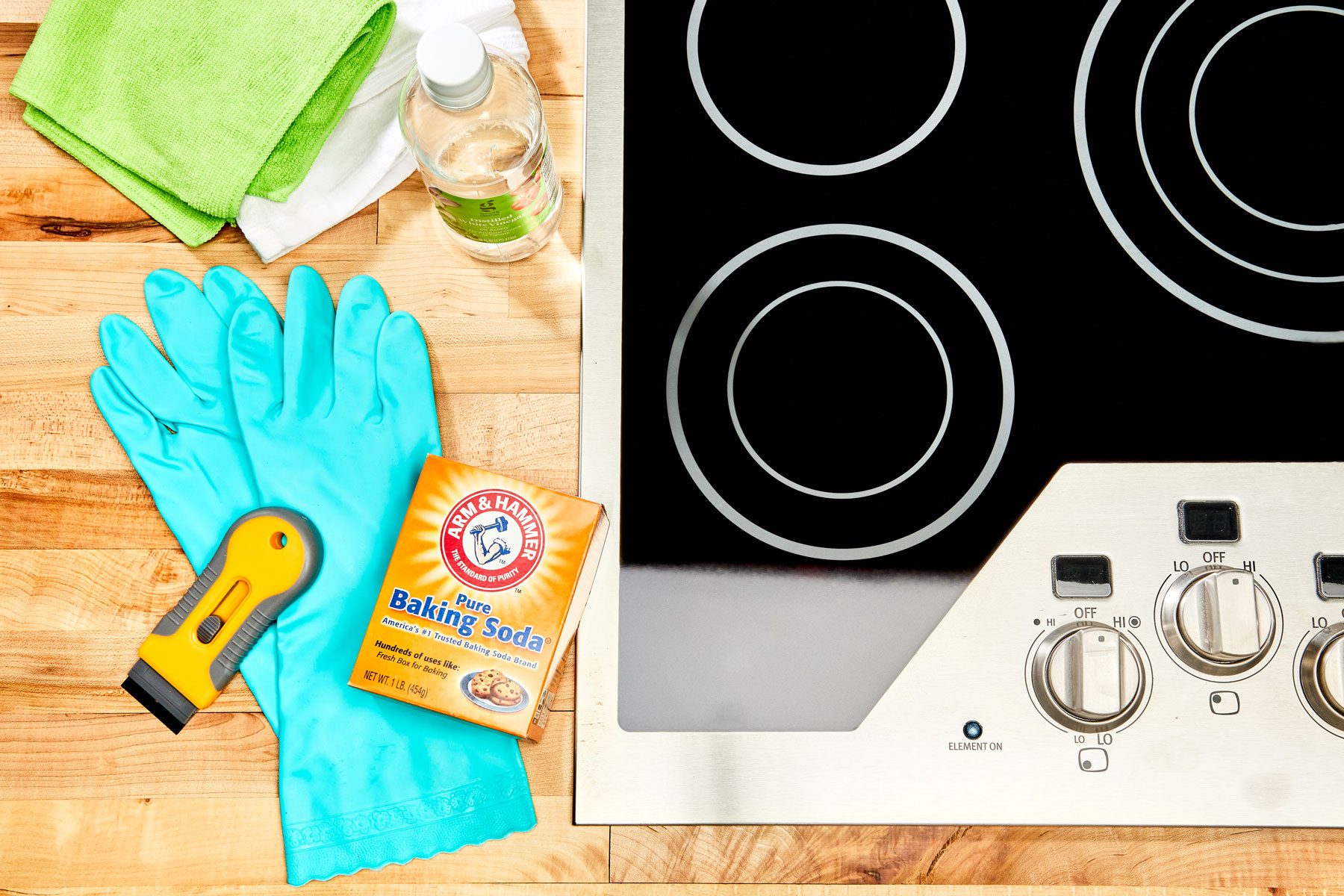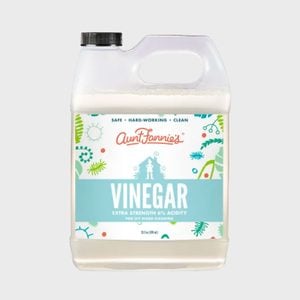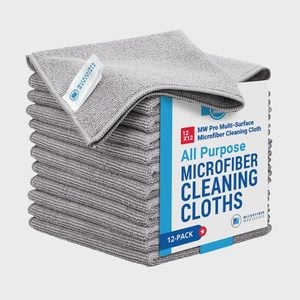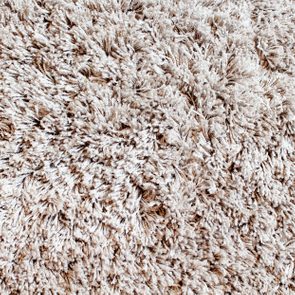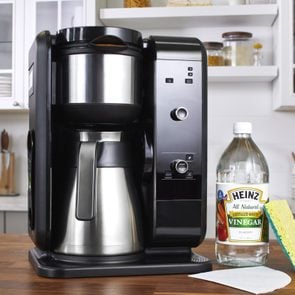Let’s face it: Cooking is messy. Spaghetti sauce splatters. A wooden spoon filled with tonight’s veggie chili doesn’t quite make it to the bowl. Once dinner turns to movie or game night, that spill will be stuck. If you wait until morning? Yikes. Not to worry. If you don’t know how to clean a glass stovetop, we’ve got you covered.
Sometimes called black glass or ceramic stovetops, these attractive cooktops are energy efficient and better than gas stoves for indoor air quality. Plus, they’re practical, since they’re also easy to clean. That’s right: Cleaning your glass stovetop doesn’t have to be a chore, says Alicia Sokolowski, president and co-CEO of AspenClean, a green cleaning company based in Canada. You probably have the cleaning ingredients in your pantry right now. Below, Sokolowski walks us through the steps and explains how to keep your glass stovetop looking its best.
Once you’ve mastered how to clean a glass stovetop, work the task into your cleaning schedule to keep it shining. Sokolowski says to shoot for once a week, but if you’re a messy cook, you might want to clean it more often. (Wipe up spills promptly to avoid extra work later.)
Get Reader’s Digest’s Read Up newsletter for more cleaning, humor, travel, tech and fun facts all week long.
How to clean a glass stovetop
The first thing to know about how to clean a glass stovetop is that it’s not made from regular, everyday window glass. You can’t just grab any old cleaner under the sink and hope for the best. Instead, Sokolowski recommends vinegar and baking soda. These all-natural cleaners are tough on grease but won’t scratch your glass stovetop.
Supplies:
Step 1: Make a vinegar solution
Make a homemade cleaning solution with one part distilled white vinegar and one part water. To do that, grab a clean spray bottle and fill it about halfway with vinegar, then fill it with warm water.
Vinegar is one of the cleaning products you should never mix with certain other cleaners, so label your spray bottle now to avoid a dangerous situation later. Besides, a label will make it easier to identify the next time you want to clean your glass stovetop.
Step 2: Wipe down stovetop
Do not try to clean a hot glass stovetop, Sokolowski says. Once the surface is cool, spray it with your vinegar solution and wipe it with a clean, damp microfiber cloth. Look for crumbs and spills at the edges, where the glass meets the stainless steel.
Step 3: Sprinkle with baking soda
Once you’ve wiped the vinegar from your stovetop, sprinkle baking soda over the entire surface of the glass. Don’t be shy. Baking soda is naturally and gently abrasive, but it won’t harm your glass stovetop’s finish.
Resist the urge to use vinegar and baking soda together on a glass stovetop. “It will produce a great science-fair volcano fizz,” Sokolowski says, but it’s not the most effective way to clean surfaces. (To use the bubbling action of vinegar and baking soda to best effect, combine the ingredients when cleaning and deodorizing garbage disposal.)
Step 4: Cover with a hot towel
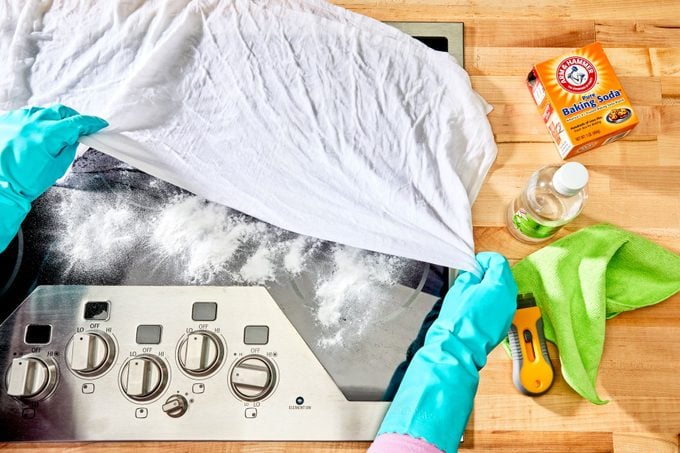 TMB Studio
TMB Studio
Fill your sink with hot water and dunk a couple of kitchen towels or an old (but clean) bath towel. Keep the water as hot as manageable, but be careful not to burn yourself. Wear rubber gloves if needed.
Remove the knobs from your ceramic stovetop, if you have them. Wring out the towels and lay them across the surface of your stovetop, covering the baking soda. Allow it to sit for 15 minutes.
While you wait, clean the knobs with a microfiber cloth and a little dish soap or vinegar. (Don’t soak them.) If you have some time left over, here’s how to clean your wooden cutting boards while you have the vinegar out.
Step 5: Scrub
After 15 minutes, pick up the towels, rinse them under hot water and wring them out. Use one of the towels to scrub the surface of your glass stovetop, working methodically from one side to the other so you don’t miss anything. Look for burn marks, stuck-on food and grease, all while applying gentle pressure. It’s better to apply more baking soda than to risk damaging your glass stovetop.
“Do not use heavy pressure while scrubbing at a tough spot,” Sokolowski says. “You may crack it. A light touch is always better!”
Don’t reach for an abrasive scrubber either. Steel wool, SOS pads, even the scrubby side of a sponge are big no-nos, according to Sokolowski.
Step 6: Use a razor blade for burnt-on food
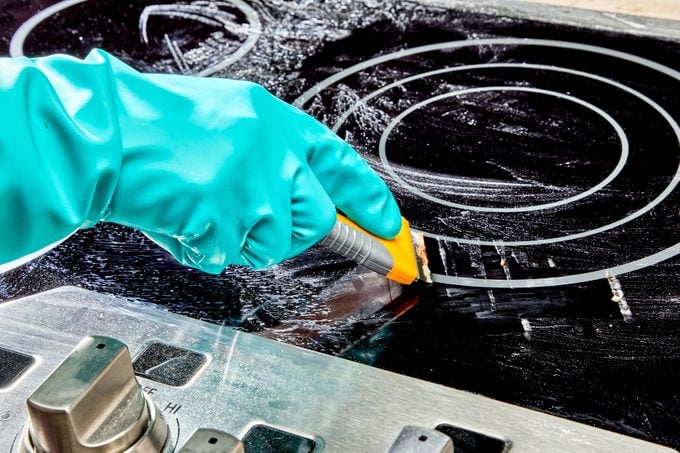 TMB Studio
TMB Studio
For those stubborn spots that just won’t budge, use a razor blade scraper. This handy tool makes quick work of stuck-on cheese or spaghetti sauce, but make sure to use it correctly to avoid scratching the glass of your stovetop, Sokolowski says.
With your stove still damp with baking soda and water residue (add more if needed), hold the scraper at a 45-degree angle to the surface. Work the scraper gently back and forth in the same direction until the food breaks free.
Razor blades are extremely sharp, so use caution when changing the blades on your scraper. And don’t toss used razor blades in the trash! You can likely wrap your razor in paper and tape, then deposit it in your municipal trash collection, but check with your city for specific requirements. Believe it or not, you can also use a razor to de-pill your clothes.
Step 7: Wipe and buff
Wipe up any scraped-off food and baking soda residue with your kitchen or bath towel. Then spray one more time with vinegar and wipe the stovetop down with a damp microfiber cloth.
You’re almost done! There’s just one more thing to do to achieve a gleaming, clean glass stovetop.
“Buff it with a dry cloth to make it shine,” Sokolowski says. Then gather your towels and microfiber cloths and toss them in the laundry.
Tools for cleaning glass stovetops
While commercial cleansers exist for cleaning a glass stovetop, Sokolowski recommends sticking with natural products. They clean well, they’re inexpensive and they’re better for your health and the environment.
Check your stove’s owner’s manual, though, for recommended cleaners and any warranty requirements. GE, for instance, recommends its own product, Cerama Bryte Cooktop Cleaner.
How to keep a glass stove clean
Now that you’ve mastered how to clean a ceramic stovetop, keep it clean by following some best practices. The most important step, according to Sokolowski? Wipe up spills as they happen.
Wait for the stovetop to cool down first! Then, while the spill is fresh, wipe it with a microfiber cloth dampened with warm water. If the stain has dried or is hard to remove, spray with a 1:1 vinegar-and-water solution before applying the cloth.
When cooking sugary liquids like candy, syrup and fudge, keep a watchful eye to avoid boil-overs. Sugar that hardens on glass stovetops becomes difficult to remove and can cause pitting of your stovetop surface. Plastic causes a similar reaction, so don’t store or place any plastic containers on your ceramic stovetop.
Try not to drag your pots and pans across the surface of your stovetop, and check the bottoms of your pans periodically to look for nicks and scratches that could damage the glass. Allowing pots to boil dry doesn’t just scorch the pot; it can leave marks on your cooktop too. If it happens to you, don’t fret. We’ll show you how to clean a burnt pot so it looks as good as new.
Pro tips for cleaning a glass stovetop
You’ve got the basics down, but Sokolowski has some more tips for how to clean a black glass stovetop. The cleaning expert advises against using commercial glass cleaners on your stovetop. Windex and other glass cleaners often contain ammonia, and ammonia and glass stoves don’t mix.
Using lemons to clean a glass stovetop is a great alternative to cleaning with vinegar, since they’re both acidic natural cleaners with grease-cutting ability. “Simply cut a lemon in half and rub it on your glass top,” Sokolowski says. “Wipe it down with a warm microfiber cloth, and you’re done!”
Sources:




















